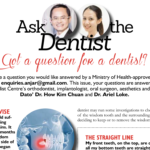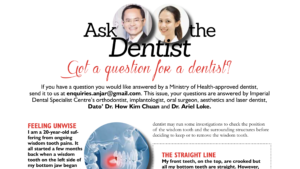

I remember when my wisdom teeth starting popping out. One word comes to mind: dreadful. I thought to myself: No wonder babies screech when their teeth are coming through! From sleepless nights to bad breath caused by difficult oral care, I prayed that the nightmare would end. While my experience was no walk in the park, once they had all broken through, all my wisdom teeth eventually grew without causing pain or discomfort. While I may be lucky enough to only experience this nightmare for a short amount of time, others may not be so fortunate. Wisdom teeth can appear to be feisty, pushing and squirming their way through the gums, resulting in crowding and impaction. If they don’t have enough space, they will grow in awkward positions, whether horizontal or even backwards. While pain, infection and bad breath may encourage removal, many choose not to undergo such procedures because of the horror stories related to wisdom tooth extractions. Deciding to live with pain may be an option, but this option can not only result in continuous discomfort, it can even result in neighbouring tooth decay. To avoid situations like these, pre-emptive care and solutions are key to a happy and healthy oral cavity.
While not many know this, everyone is born with something called a tooth germ. While it’s technically not a tooth yet, you already have the seeds in which wisdom teeth will blossom come adulthood. As you age – usually around the age of 16 or 17 – your wisdom tooth will actually start crowning or, in other words, erupt into the oral cavity. Once the tooth continues
growing and reaches two thirds of its length, it will begin erupting in the mouth. After the tooth has erupted, it will take another two to three years for the wisdom tooth to completely form. Many may experience discomfort during wisdom tooth eruption because any form of teething is painful. A perfect example would be teething babies. A reason why babies gnaw on toys or cry is because teething hurts.
Dato’ Dr. How Kim Chuan from the Imperial Dental Specialist Centre explained the complexities of wisdom teeth formation.
“The physiology behind this discomfort is because once the tooth begins pushing its way out, bone resorption happens and this process will cause inflammation and pain. Once children are older and their first molars erupt, they will of course feel discomfort due to this same process.”

The last stage of teething is, of course, when you are reaching adulthood. This would be the third and last phase of pain one will have to endure. While physiologically similar, all three phases of teething come with different levels of discomfort because different age groups will convey discomfort differently.
“Wisdom tooth formation is painful because bone at 16 to 17 would have fully reached its mature stages and thus, is very dense. Once bone has reached maximum density, it actually takes bigger force to push through both bones and gums,” Dr. How says. Dr. How also states that when wisdom teeth begin to erupt, infection caused by bacteria stagnation can also mean pain or discomfort.
Because every other tooth has already formed, wisdom teeth will, unfortunately, be impacted due to the limited space in which wisdom teeth can comfortably sit. Once the oral cavity becomes crowded from wisdom tooth formation, its unfavourable positioning will commonly lead to infection caused by food residue and difficult oral care and hygiene. Once infection hits, many patients will experience pain and swelling. Much like an appendix removal, wisdom tooth removal is only necessary if it causes problems.
ISSUES WITH IMPACTION
Dr. How says, “If the tooth has erupted in an impacted position resulting in food regularly lodged within the area, removal may be required. This is because incessant food residue companied with poor brushing can cause bleeding, swelling, infection, bone loss and even neighbouring tooth decay.” He goes on to explain that once the neighbouring tooth begins to decay, you will end up not only losing one tooth but two. In the end, rather than having to pluck out two teeth, patients may choose to pre-emptively remove the wisdom teeth to avoid all related issues. While many may assume removal may only occur after the tooth is fully grown, this isn’t the case. Once the tooth is impacted, it will be perpetually stuck and can only be resolved via surgical measures.
REMOVING WISDOM TEETH
What happens with wisdom tooth removal depends on whether it’s positioned on the upper or lower set of teeth. Dr. How agrees that if the tooth is located on the upper set of teeth, removal is much easier because the supporting bone is less dense resulting in decreased resistance during extraction.
With the lower set of teeth, Dr. How states, “The bones are very dense and if the wisdom tooth has erupted into the same impacted position and similar force is used, the resistance will cause the tooth to break within its cavity. Because we don’t want this to happen, we practice something called ‘divide and rule’”.
To do this, Dr. How will, firstly, section the tooth into separate pieces and then remove the parts, one by one. He does this so that he is able to remove the tooth without damaging any related structures. Apart from sectioning the tooth, he may also remove a bit of bone surrounding the tooth to minimise resistance and increase mobility.
“The technique in which removal is carried out depends on the anatomical position of the tooth. As a surgeon, once the tooth’s position is fully understood, surgical complexity can be determined,” Dr. How says. Many patients tend to steer clear of wisdom tooth removal due to pain, increased swelling and bleeding. While this may be common, choosing the right surgeon with adequate surgical know-how can result in minimally-invasive techniques and increased patient experience and comfort.
Apart from this, wisdom teeth are also unfortunately located extremely close to the surrounding nerves.
“Because the tooth germ is nourished by the blood vessels and nerves, the tooth will grow very close to the nerves and, if the tooth is impacted, the closer will be the proximity to the surrounding nerves,” he states. Once the tooth is at a close proximity, this becomes a complication resulting not only in swelling but lip numbness, post surgery. To avoid this, surgeons have to make sure that the depth of cutting is far away from the nerve. In summation, wisdom tooth removal requires a lot of training and Dr. How does recommend patients to choose a more experienced dental surgeon to carry out the procedure. To find out if complications such as nerve damage can arise, patients are required to firstly, have an X-ray.
Like any invasive procedure, patients will definitely experience five cardinal signs: inflammation bleeding, pain, redness, swelling and heat. The severity of the five signs, on the other hand, can differ according to surgical technique, the patient’s immune system and medication. Anti-inflammatories are prescribed so that swelling can be curbed. Other than that, post-operative care is also of utmost importance. Many patients do not understand the significance of applying light pressure by biting on gauze.
This is why Dr. How always stresses that although patients do not  bleed, they will still have to apply light pressure to minimise the chances of internal bleeding. If there is no pressure and internal bleeding happens, the body has to work twice as hard to clear the bleeding. This results in prolonged swelling. Another practice that patients have to steer clear from is ice application to the warm and swollen region. While applying ice or the consumption of cold drinks may indeed take away the heat, the body will work in such a way that if you take away heat, more heat will come.
bleed, they will still have to apply light pressure to minimise the chances of internal bleeding. If there is no pressure and internal bleeding happens, the body has to work twice as hard to clear the bleeding. This results in prolonged swelling. Another practice that patients have to steer clear from is ice application to the warm and swollen region. While applying ice or the consumption of cold drinks may indeed take away the heat, the body will work in such a way that if you take away heat, more heat will come.
Dr. How says, “While ice may help remove pain temporarily, the moment the ice or cold sensations deplete, the body will have to defrost the affected area, resulting in increased swelling.” Many patients only seek consultation when they experience unbearable pain and swelling caused by an infected and bacteria-ridden wisdom tooth. This can also result in increased post-operative discomfort. This is because the body has to firstly clear off the infection before it can begin healing itself.
This is why Dr. How actually advocates preventative care such as general routine check-ups and X-rays. Dr. How states, “Once we practice prophylactic wisdom tooth removals, patients can benefit from a relatively pleasant procedure. If it’s too late and extractions have to be carried out as an emergency procedure, infections would have already hyper-sensitised pain thresholds resulting in painful surgical measures and post-operative care.”







